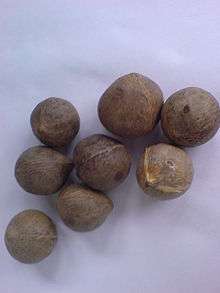Coquito nuts

Coquito nuts are the fruits from a feather-leaved palm, Jubaea chilensis, native to Chile, having a thick trunk from which is obtained a sugary sap used for making wine and a syrup, and widely cultivated as an ornamental in warm dry regions.[1] (Spanish, diminutive of coco, coco palm, from Portuguese côco; see coconut.) Coquito nuts look like miniature coconuts and have a very similar flavor to coconuts. They have a brown exterior and a white interior with a hollow center. They measure about 1⁄2 to 3⁄4 inch (1.3 to 1.9 cm) in diameter. They are completely edible (raw or cooked), and are crunchy, with an almond-like sweetness.[2]
History
Coquito nuts, also referred to as coker nuts, pygmy coconuts or monkey's coconut, are the fruit of a Chilean palm tree. The tree, Jubaea chilensis, takes up to fifty years to achieve maturity, and is native to the coastal valleys of Chile. This palm is grown in Mediterranean-type climates worldwide, including in the state of California.[3]
Usage
Coquito nuts can be eaten whole, raw or cooked. Whole or chopped coquito nuts can be added to a variety of foods, including desserts, savoury foods, and drinks. They are grown year round, and will stay edible for up to three weeks if kept in a refrigerator.[4]
Nutritional information
Below is a table of nutrients contained with 1 serving (g) of coquito nuts, based on a 2000 calorie diet.[5]
| Nutrients | Amount | Pct daily value |
|---|---|---|
| Total calories | 110 (90 cals from fat) | - |
| Total fat | 10 grams | 15% |
| Saturated fat | 9 grams | 45% |
| Sodium | 5 milligrams | 0% |
| Carbohydrates | 5 grams | 2% |
| Dietary fibre | 3 grams | 12% |
| Sugars | 1 gram | 0% |
| Vitamin A | - | 0% |
| Vitamin C | - | 0% |
| Calcium | - | 0% |
| Iron | - | 4% |
References
- ↑ "Coquito Definition". Retrieved 15 May 2012.
- ↑ "Coquito Nuts | Taste Spotting". Retrieved 15 May 2012.
- ↑ "Baby Coconuts". Farmers Market. Retrieved 15 May 2012.
- ↑ "Coquito Nut- History". Retrieved 15 May 2012.
- ↑ "Calorie Counter". Retrieved 15 May 2012.